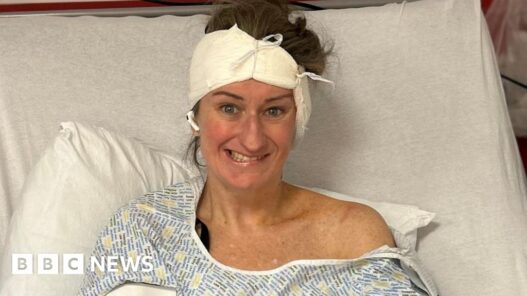 Susannah Morgan
Susannah MorganWhen Susannah Morgan learned that surgery to remove a benign tumor in her neck could leave her with a crooked smile, she was “frantic.”
The 45-year-old was advised to have it removed in case it turned cancerous, but was warned the surgery would also leave her with a dent in her neck and possibly paralysis.
Desperate to avoid being permanently disfigured, she looked for alternatives and discovered a new technique using a 3D image that could save her smile.
Last month, the mother, from Edinburgh, became the first person to undergo this pioneering procedure in Scotland.
 Susannah Morgan
Susannah MorganShe was initially told that to remove the pleomorphic adenoma, surgeons would have to cut out her largest salivary gland, which contains the facial nerve.
But new hologram technology allows surgeons to pinpoint the exact location of the facial nerve, reducing the chance of cutting it.
It also allows surgeons to open the salivary gland, rather than remove it.
Susanna paid for a high-tech MRI scan in London, which produced a 3D image.
It was then used by Ian Nixon, the surgeon who performed the operation, in Livingstone, West Lothian, last month.
“Ian saved my smile and I’m so grateful to him,” Susanna told BBC Scotland News.
“I feel on top of the world, I’m on top of my game and it gives me a real buzz.”
 Susannah Morgan
Susannah MorganWhen she woke up from surgery, Susanna’s smile was crooked, but paramedics explained this was temporary because the facial nerve had to be moved to reach the tumour.
She said: “I cried when I saw the strabismus smiling straight after surgery, so thinking that it could have been permanent if Ian had not used this pioneering technique is not worth thinking about.”
“He had to lift the facial nerve, which looks like a piece of spaghetti, to get to the tumor, and because he had to manipulate it manually, they say he bruises it, which temporarily weakens it.”
She said that if it had been cut by accident during the operation, she would have been permanently paralyzed in her face.
New hologram technology has made it less likely for a surgeon to have an accident.
 Susannah Morgan
Susannah MorganSusanna went to the doctor for the first time at the end of November 2022 after finding a lump under her ear.
However, the trainee doctor thought it was just a salivary stone and asked her to eat sour sweets to release the salivary juices.
“It’s so rare that a lot of GPs don’t know about it and they had blood drawn and they were all fine so it was just rejected.
“I didn’t think much of it because I thought it was a little swollen and I didn’t think it was a tumor.”
But then it started to grow and she could see it bulging out from her neck until it reached 3.5cm (one inch), so she went back to the doctor a year later.
“I was really shocked when I was told it was a tumor. I was relieved to learn it was benign, but he told me that if I couldn’t remove it it might turn into cancer.”
“Some people choose not to have surgery because it’s really scary to have surgery on the facial nerve because there are a lot of risks involved.”
 Susannah Morgan
Susannah MorganNixon, Susanna’s surgeon, said people have six major salivary glands, and Susanna’s tumor was located in the largest one, under the ear.
“This is a ground-breaking technology and allows for a more invasive approach to surgery on tumors that can be quite disfiguring, and this holds promise for the possibility of surgery with fewer side effects as a result.
“With the traditional procedure, you lift the skin and you have to be careful not to damage the nerve because you know it has to be close.
“But if you know where it is before you start, you can be more confident and more targeted.
“This is the advantage of this pioneering technology and makes it safer.”
He added that the operation saved her smile and preserved the dent in her neck.
“It’s very exciting and I think this will become standard procedure in the future.”




















